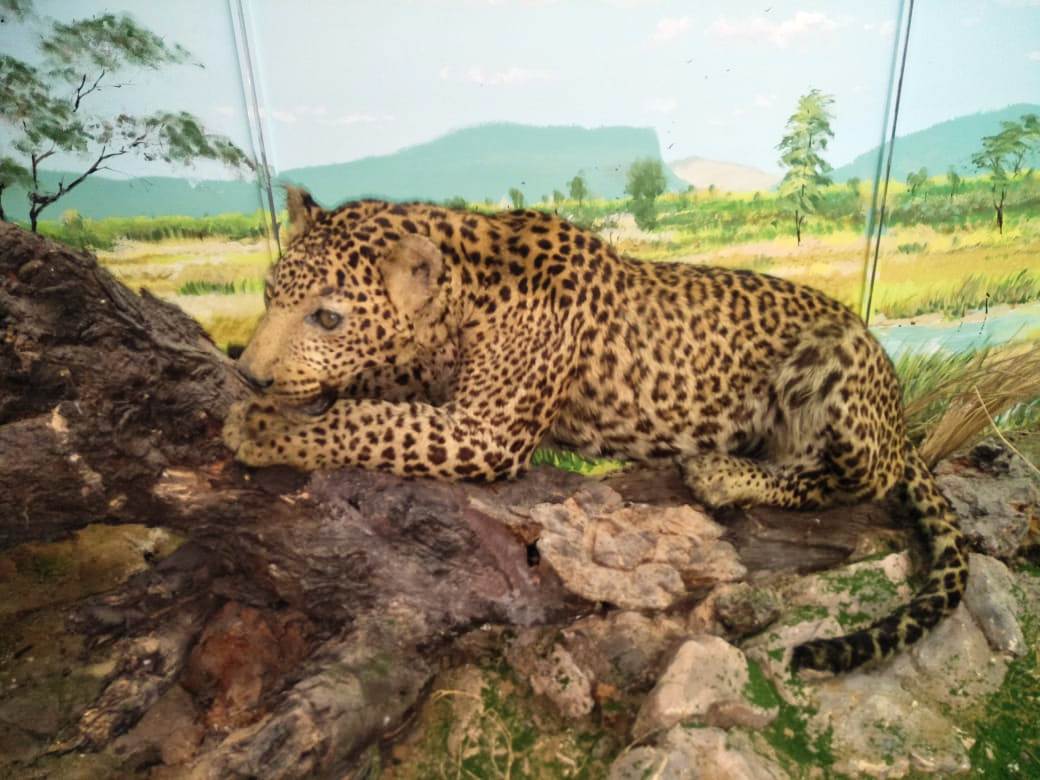- Home
- Regional Museums
- RGRMNH Sawai Madhopur
- Biodiversity in Rajasthan:
- The gallery on Biodiversity of Rajasthan showcases Rajasthan’s unique biodiversity, types of forest and its association with nature. It is also focused on biodiversity of Rajasthan v/s India.
- This gallery gives information about desert animals, medicinal plants and endangered flora & fauna also.
- Mandna art/tribal art focused on value of animals and plants which are illustrated with natural colours.
- Biodiversity of Rajasthan consider dioramas on Man & Nature, Bishnoi Community, Two faces of the Forest-Afforestation & Deforestation, Ranthambhore National Park showed different angles of flora and fauna of the Rajasthan.
- Digital panels explain eco-zones of Rajasthan, social and religious animals & plants.
- Kiosk digitally able to explain Biosphere, Indian national park and sanctuary.
- Digital Photo frames showing glimpses of animals and plants with common name and scientific names.
- Digital kiosk put MCQs for visitors to solve the same.
- Biodiversity of Western Ghats:
- Western Ghats or Sahyadris are the mountain ranges which are spread across different states like: Gujarat, Maharashtra, Goa, Karnataka, Kerala and Tamil Nadu.
- The average elevation of Western ghats is 1200 m with highest peak Anamudi in Kerala reaching up to 2695 m above sea level. These mighty mountains are one of the biodiversity hot spots of World having many endemic species of plants and animals.
- Some of the endemic species found are Lion Tail Macaque, Nilgiri Thar, Malabar gliding frogs, apart from these there numerous species of rare and endemic orchids found in this landscape. These mountain ranges are very important for every existence of Humans in peninsular India providing many resources. One of such resource is water. Many perennial rivers like Godavari, Krishna, Tungabhadra, Cauvery which runs through peninsular India have origin in Western Ghats. Presently these mountains are in great danger with unplanned developments, illegal mining and deforestation.
- Western Ghats gallery beautifully depict its biodiversity, people, culture and problems it currently facing.
- Bird Diversity in Rajasthan:
- This gallery contains open dioramas on walk through Forest, Birds in courtyard, Desert National Park and Indian National Bird-The Peacock with full of details.
- Developed another dioramas on Scavenger birds, Sambhar Salt Lake-greater Flamingo, The Great Indian Bustard, Egg showcase for different birds, Tallest Flying Birds-The Sarus Crane and Keoladeo National Park showing untouched dimensions of various birds (both migratory and domestic).
- Showcases on Types of beak, Types of Feet, Birds of Semi-arid Region and Interesting birds with taxidermy models.
- This gallery is able to explain various issues, facts, values, significant rolls, challenges and conservation of the birds through panels like as Avian tree- origin of birds, status of birds through India v/s Rajasthan, Habitat, Connecting link-Archaeopteryx, Preying birds, adaptation, Flight mode, Natural Architect-bird’s Nest, kite festival, Dr. Salim Ali- Bird Man, traditional values, religious importance, Folkore and economical value, bird’s pollination etc.
- Adaptation in Desert Flora & Fauna:
- This gallery explains difficult life of desert animal and plants in adverse condition of Thar Desert.
- Mounted specimens of monitor lizard, calotes and Hedgehog displayed in table top covered with glass.
- Dioramas of mounted specimens of five bar squirrel, Black Buck and great Indian Bustard explain desert ecosystem along with text panels.
- Flora & Fauna of RTR:
- This gallery is as an interpreting centre on “Ranthambhore Tiger Reserve”. This is very important for who are visiting RTR, SWM.
- This gallery contain dioramas on Leopard, Striped Hyena, Tiger, Tiger’s head Trophy and egg shell showcases with its habitat.
- This gallery explains meaningfully about major animals and plants who played vital role to sustain good population of Tigers and leopard etc.
- Mammalian Series:
- This gallery is dedicated to real and rare taxidermy mounted specimens fixed in beautiful showcases which are covered with glass.
- Mounted specimens of primates as Slender loris, Golden Langur and Grey Langur showed systematically origin/evolution of mammals.
- Sloth Bear, Spotted deer, leopard cat, The Indian Pangolin, Snow Leopard, Marbled Cat, Armadillo, Nilgiri Tahr, Red Panda and Mouse deer are displayed in different showcases along with full of details to enhance the knowledge of the users.
- While a mounted lioness has been displayed in central with its habitat along with Chinkara and white Tiger dioramas.
- Tribes of India:
- This exhibition focused on Tribes of India with special references to Rajasthan’s Tribes like as Dhanka, Kathodi,Mina, Damor, Bhil, Nayaka, Sahariya, Gharasia etc.
- It is also focused on Tribal development, Tribal development in India-Social welfare, Tribes Traditional Knowledge, cultural and socio-economic life etc.
- A diorama is also dedicated to Kathodi Tribes with its natural house.
- Seeds of India:
- Seeds of India focused with what is agricultural tradition, cereals, Pulses, oil seed, Dry nuts. Spices, Importance of seeds & seed storage and pollination, seed & its dispersal etc.
- A diorama is also dedicated to crop harvesting and added successfully.
- Heritage sites of India:
- This exhibition is focused on Natural Heritage sites of India, cultural Heritage Sites of India and Mixed heritage sites of India etc.
- UNESCO World heritage sites of India are very meaningful to aware visitors.
- Miniature diorama on Kaziranga National Park is also developed to understand the values of Natural heritage sites.
- Textiles of India:
- This exhibition is focused on scenario of Indian Textile Industry, source and kinds of fibres, origin and history of textile in India, embroidered textiles of India, Resist dyed textiles in India, Printed & hand woven textiles of India etc which is very important to understand our rich culture.
- Kinds of textiles exhibited in a showcase which belongs to different parts of India.
- Water Conservation:
- This exhibition is focused on average Rainfall in India, Water-facts in India, Water cycle, Impact of climate change on water resources, water pollution in India, Role of afforestation in water conservation etc to enhance the knowledge of visitors.
- A model for save water-save life has also been displayed.
- Plastic Pollution:
- This exhibition is focused for plastic pollution: a threat to ecosystem, Types of Plastic, causes of Plastic pollution, impacts of plastic on environment and how to control plastic pollution as Reduce, Reuse and Recycle etc.
- This exhibition is focused for plastic pollution: a threat to ecosystem, Types of Plastic, causes of Plastic pollution, impacts of plastic on environment and how to control plastic pollution as Reduce, Reuse and Recycle etc.
- Scientific Sketches of Biological Specimens:
- This exhibition is very unique using Crow Quill “dip nib”: Icing with Indian Ink and followed traditional knowledge to preserve biological specimens.
- Scientific Sketches of Biological Specimens under microscope covers longitudinal and transverse section of Roots, leaf, stems, larvae, tissue, cell and organs etc.
- Unicellular animals and plants are also highlighted along with other specimens as arthropods, annelids, mollusc, Helminthes etc.
- Exhibition on activities by differently challenged children (MR, HI, VI and PH):
- This exhibition is dedicated to differently challenged children who took part in different competition like as collage, sand art, painting, swirl art, stick art and clay modelling competition etc which is organized by this museum.
Last Updated On September 15, 2021
Exhibits/Galleries

Rajiv Gandhi Regional Museum of Natural History, Sawai Madhopur developed different thematic galleries and exhibitions based on school curriculum which plays a vital role to enhance the knowledge of the visitors.
GALLERIES:
EXHIBITIONS:
 Skip to Main Content
Skip to Main Content








